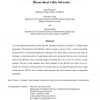Free Online Productivity Tools
i2Speak
i2Symbol
i2OCR
iTex2Img
iWeb2Print
iWeb2Shot
i2Type
iPdf2Split
iPdf2Merge
i2Bopomofo
i2Arabic
i2Style
i2Image
i2PDF
iLatex2Rtf
Sci2ools
NETWORKS
2002
2002
Node-disjoint paths and related problems on hierarchical cubic networks
An n-dimensional hierarchical cubic network (denoted by HCN(n)) contains 2 n n-dimensional hypercubes. The diameter of the HCN(n), which is equal to n+(n+1)/3+1, is about two-thirds the diameter of a comparable hypercube, although it uses about half as many links per node. In this paper, a maximal number of node-disjoint paths are constructed between every two distinct nodes of the HCN(n). Their maximal length is bounded above by n+n/3+4, which is nearly optimal. The (n+1)-wide diameter and n-fault diameter of the HCN(n) are shown to be n+ n/3+3 or n+n/3+4, which are about two-thirds those of a comparable hypercube. Our results reveal that the HCN(n) has a smaller wide diameter and fault diameter than a comparable hypercube.
| Added | 22 Dec 2010 |
| Updated | 22 Dec 2010 |
| Type | Journal |
| Year | 2002 |
| Where | NETWORKS |
| Authors | Jung-Sheng Fu, Gen-Huey Chen, Dyi-Rong Duh |
Comments (0)

